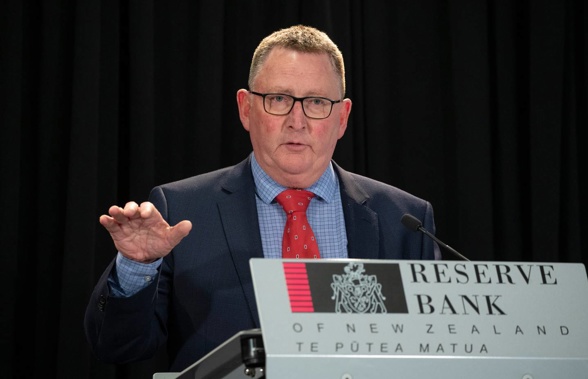
Independent economist Rodney Jones is urging the Reserve Bank of New Zealand (RBNZ) to stop figuratively printing money, with inflation at a three-decade high.
Jones, of Wigram Capital, says the RBNZ needs to prioritise decreasing the supply of money, rather than just focussing on increasing the cost of money (by hiking interest rates), to curb inflation.
The amount of liquidity in New Zealand's financial system (New Zealand's "monetary base") has increased almost four-fold since February 2020, when the RBNZ started printing money in response to Covid-19.
New Zealand-registered banks and other approved financial institutions have a record $47 billion in their settlement accounts held by the RBNZ – $40b more than in February 2020.
There is a further $9b of currency in circulation – $2b more than in February 2020.
Speaking to the Herald, Jones said the RBNZ urgently needs to reduce the amount of bank deposits it holds.
This would help lower inflation.
It would also save taxpayers money, as the RBNZ needs to pay banks interest on the $47b of deposits they currently have with the central bank.
What's more, if the RBNZ does more to remove cash from the system, it might not have to lift the Official Cash Rate (OCR) as aggressively as it is.
How exactly can the RBNZ remove liquidity from the system?
Jones is adding his name to the list of commentators urging the RBNZ to stop creating money and lending it to banks at the OCR.
Since launching its Funding for Lending Programme in December 2020, the RBNZ has lent banks $12b.
This is equivalent to 27 per cent of the increase in bank lending that occurred between December 2020 and April 2022.
The idea behind the Funding for Lending Programme was to provide banks with a source of funding, should they struggle to attract deposits in the event of the OCR being cut into negative territory.
The RBNZ committed to keeping the facility available until December this year.
Jones said it needs to go, as it's incongruent for the RBNZ to be tightening monetary conditions by hiking the OCR with one hand, and loosening conditions by adding to the money supply with the other.
The RBNZ argues it needs to stick to its word and keep the programme in place for as long as it said it would.
Jones said this is counterproductive – the situation's changed, and so should the RBNZ's policy.
What's the second way Jones wants the RBNZ to reduce the supply of money?
Jones also suggests the RBNZ dumps the swathe of bonds it bought in 2020 and 2021 as a part of its Large-Scale Asset Purchase programme, otherwise known as quantitative easing.
The RBNZ created money to buy $53b of New Zealand Government Bonds from banks, which bought them from the Treasury. These purchases helped top up banks' accounts with the RBNZ.
The idea was that if the RBNZ became a very active player in the bond market, bond yields would fall, which would put downward pressure on interest rates more generally.
The RBNZ wanted interest rates to be low to support people with debt, and encourage more borrowing and spending at a time it feared the economy would struggle.
Once the economy started recovering, the RBNZ stopped the bond purchases in July 2021.
It will, from next month, start gradually selling the bonds directly back to the Treasury, which will retire them.
If all goes to plan, all the government bonds the RBNZ bought will either have matured or been sold by mid-2027.
The RBNZ wants to shrink the size of its balance sheet to make it easier for it to potentially use bond-buying again in a future downturn.
Jones maintains the shrinking should've started sooner, and now needs to occur faster.
He believes the RBNZ should sell some of the bonds on the open market, back to the banks it bought them from. This would reduce the $47b of deposits they have at the RBNZ.
The RBNZ is paying the banks interest at the OCR (which is rising) on these deposits. At 2 per cent, the RBNZ is paying $940 million on the $47b of deposits.
The RBNZ has opted to sell the bonds back to the Treasury because it fears dumping them on the open market could cause dysfunction – particularly if it was selling at the same time the Treasury was issuing a bunch of new bonds.
However, Jones said the RBNZ and Treasury could co-ordinate to avoid the sell-off being disruptive.
He believes the Treasury could also buy some bonds from the RBNZ, using some of the excess cash the Crown has in its account with the RBNZ. This settlement account currently has $27b in it.
This is high by historic standards, as the Crown has borrowed more than it's spent in recent years. In February 2020, there was only $9b in the Crown settlement account.
Nonetheless, because the RBNZ is only going to sell the bonds to the Treasury, the Treasury plans to issue up to $20b of new bonds to fund these purchases. This is a material amount of money.
Issuing more debt, particularly in a rising interest rates environment, costs taxpayers.
Jones believes this arrangement is avoidable and doesn't help reduce the supply of money in the financial system quickly.
Again, he stressed tightening monetary conditions by shrinking the supply of money, might enable the RBNZ to increase the cost of money less aggressively.
Take your Radio, Podcasts and Music with you









